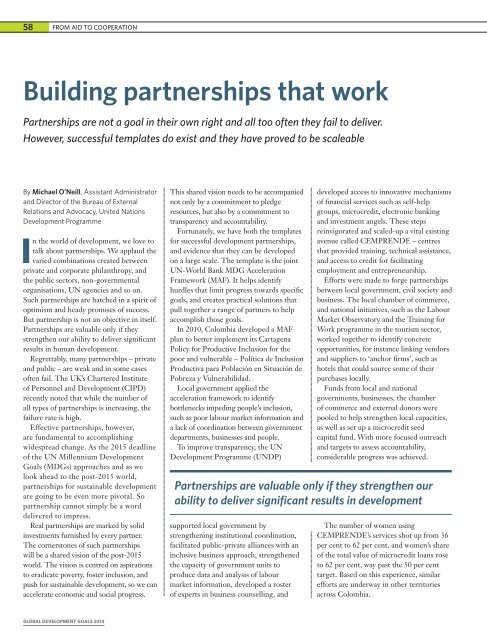FAMBB
FAMBB
FAMBB
Create successful ePaper yourself
Turn your PDF publications into a flip-book with our unique Google optimized e-Paper software.
58 FROM AID TO COOPERATIONBuilding partnerships that workPartnerships are not a goal in their own right and all too often they fail to deliver.However, successful templates do exist and they have proved to be scaleableBy Michael O’Neill, Assistant Administratorand Director of the Bureau of ExternalRelations and Advocacy, United NationsDevelopment ProgrammeIn the world of development, we love totalk about partnerships. We applaud thevaried combinations created betweenprivate and corporate philanthropy, andthe public sectors, non-governmentalorganisations, UN agencies and so on.Such partnerships are hatched in a spirit ofoptimism and heady promises of success.But partnership is not an objective in itself.Partnerships are valuable only if theystrengthen our ability to deliver significantresults in human development.Regrettably, many partnerships – privateand public – are weak and in some casesoften fail. The UK’s Chartered Instituteof Personnel and Development (CIPD)recently noted that while the number ofall types of partnerships is increasing, thefailure rate is high.Effective partnerships, however,are fundamental to accomplishingwidespread change. As the 2015 deadlineof the UN Millennium DevelopmentGoals (MDGs) approaches and as welook ahead to the post-2015 world,partnerships for sustainable developmentare going to be even more pivotal. Sopartnership cannot simply be a worddelivered to impress.Real partnerships are marked by solidinvestments furnished by every partner.The cornerstones of such partnershipswill be a shared vision of the post-2015world. The vision is centred on aspirationsto eradicate poverty, foster inclusion, andpush for sustainable development, so we canaccelerate economic and social progress.This shared vision needs to be accompaniednot only by a commitment to pledgeresources, but also by a commitment totransparency and accountability.Fortunately, we have both the templatesfor successful development partnerships,and evidence that they can be developedon a large scale. The template is the jointUN-World Bank MDG AccelerationFramework (MAF). It helps identifyhurdles that limit progress towards specificgoals, and creates practical solutions thatpull together a range of partners to helpaccomplish those goals.In 2010, Colombia developed a MAFplan to better implement its CartagenaPolicy for Productive Inclusion for thepoor and vulnerable – Política de InclusionProductiva para Población en Situación dePobreza y Vulnerabilidad.Local government applied theacceleration framework to identifybottlenecks impeding people’s inclusion,such as poor labour market information anda lack of coordination between governmentdepartments, businesses and people.To improve transparency, the UNDevelopment Programme (UNDP)developed access to innovative mechanismsof financial services such as self-helpgroups, microcredit, electronic bankingand investment angels. These stepsreinvigorated and scaled-up a vital existingavenue called CEMPRENDE – centresthat provided training, technical assistance,and access to credit for facilitatingemployment and entrepreneurship.Efforts were made to forge partnershipsbetween local government, civil society andbusiness. The local chamber of commerce,and national initiatives, such as the LabourMarket Observatory and the Training forWork programme in the tourism sector,worked together to identify concreteopportunities, for instance linking vendorsand suppliers to ‘anchor firms’, such ashotels that could source some of theirpurchases locally.Funds from local and nationalgovernments, businesses, the chamberof commerce and external donors werepooled to help strengthen local capacities,as well as set up a microcredit seedcapital fund. With more focused outreachand targets to assess accountability,considerable progress was achieved.Partnerships are valuable only if they strengthen ourability to deliver significant results in developmentsupported local government bystrengthening institutional coordination,facilitated public-private alliances with aninclusive business approach, strengthenedthe capacity of government units toproduce data and analysis of labourmarket information, developed a rosterof experts in business counselling, andThe number of women usingCEMPRENDE’s services shot up from 36per cent to 62 per cent, and women’s shareof the total value of microcredit loans roseto 62 per cent, way past the 50 per centtarget. Based on this experience, similarefforts are underway in other territoriesacross Colombia.GLOBAL DEVELOPMENT GOALS 2014


